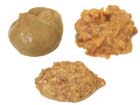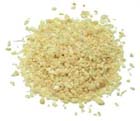|
|
Glossary Selection
Palm nut oil | |||
 | Natural Red Palm Oil is produced from the fruit of the oil palm, Elaeis guineensis. It is a vegetable oil, not from an animal or dairy product and therefore does not contain any cholesterol. Natural Red Palm Oil is sometimes confused with Palm Kernel Oil. These are quite different in composition. Palm Kernel Oil is similar to Coconut oil in fatty acid composition which makes it a good oil, yet it is much different than oil made from the fruit. Palm Kernel Oil does not contain the high amounts of antioxidants found in Natural Red Palm Oil. | ||
Joloff rice | |||
| Joloff rice is a spicy chicken and rice. | |||
Mealie and Mealie meal | |||
| Maize of American Indian corn, a drier type of field corn. Stone ground white cornmeal substitutes | |||
Niter Kibbeh | |||
| Ethiopian spiced butter oil. Clarified butter to which nutmeg, cinnamon, and cardamom seeds are added with turmeric for color, browned, strained and uses as seasoning and cooking oil in Ethiopia | |||
Gari | |||
 | Gari is a type of tsukemono (pickled vegetables). It is sweet, thinly sliced young ginger that has been marinated inside a solution of sugar and vinegar. Gari is often served and eaten with sushi. Although many brands of commercially produced gari are colored to promote sales, the actual pickle is naturally pink in colour. This is likely the result of chemical compounds inside the ginger reacting or denaturing due to the added vinegar, thus creating a red color. | ||
Garden eggs | |||
 | Term for a small green skinned African eggplants. | ||
Gombo | |||
| The West African word for Okra, American derivative of any stew using okra is called a gumbo | |||
Elubo | |||
| Yam flour | |||
Foofoo | |||
| A mashed yam, corn, and plantain pudding. | |||
Groundnuts | |||
| The peanut or groundnut (Arachis hypogaea) is a species in the pea family Fabaceae native to South America. It is an annual herbaceous plant growing to 30 to 50 cm (one to one and a half feet) tall.The leaves are alternate, pinnate with four leaflets (two opposite pairs; no terminal leaflet), each leaflet 1 to 7 cm (1/3 to 2.75 inches) long and 1 to 3 cm (1/3 to 1 inch) broad. The flowers are a typical peaflower in shape, 2 to 4 cm (3/4 to one and a half inches) across, yellow with reddish veining. After pollination, the fruit develops into a legume 3 to 7 cm (1 to 2 inches) long containing 2 to 3 (rarely 1 or 4) seeds, which forces its way underground to mature. Although a nut in the culinary sense, in the botanical sense the fruit of the peanut is a woody, indehiscent legume or pod and not technically a nut. Peanuts are also known as earthnuts, goobers, goober peas, pindas, pinders, manila nuts and monkey nuts (the last of these is often used to mean the entire pod, not just the seeds). | |||




